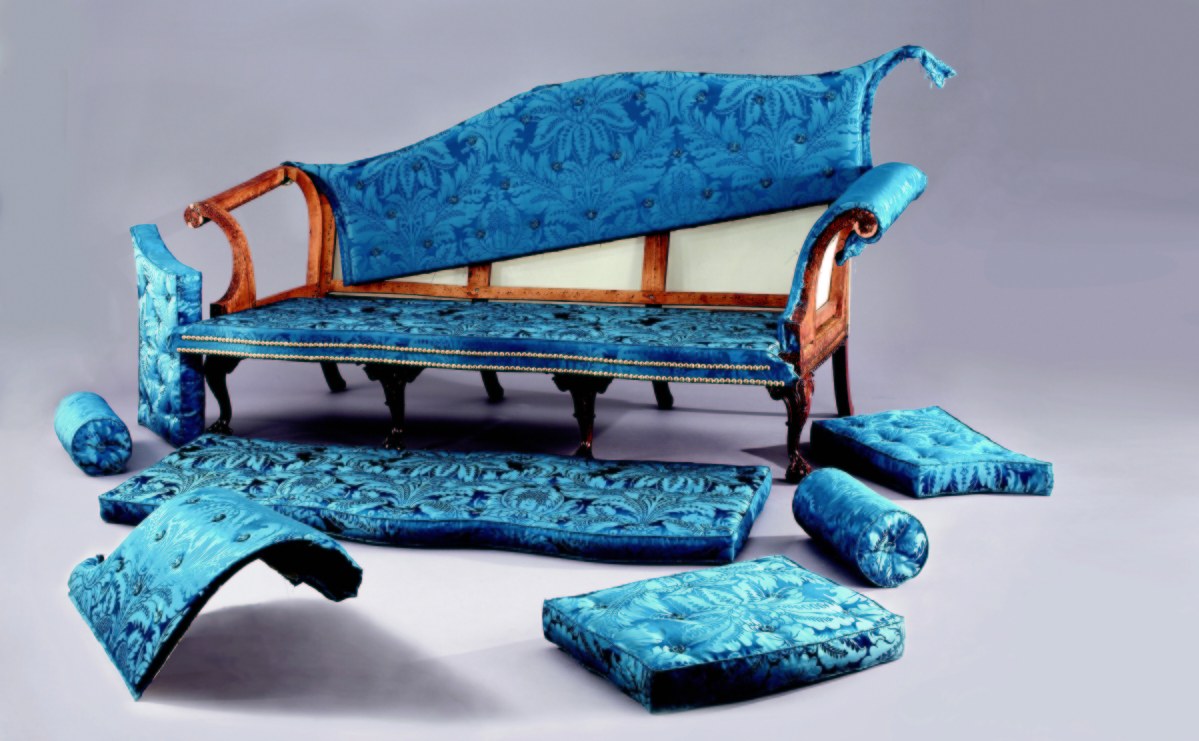
A partially assembled nonintrusively reupholstered sofa frame, sofa frame, England, circa 1760, mahogany and beech, museum purchase, 1963-191.
WILLIAMSBURG, VA. – While forensics is a hot topic, not many people would think to apply this kind of detective work to determine how Seventeenth, Eighteenth and early Nineteenth Century seating furniture was originally upholstered and what it looked like. These investigation tactics, however, are exactly what are employed in the furniture conservation labs of the Colonial Williamsburg Foundation every day, along with the scholarship of furniture curators. This spring, visitors to the DeWitt Wallace Decorative Arts Museum, one of the art museums of Colonial Williamsburg, will learn how to look for clues like the experts in a new interactive exhibition, “Upholstery CSI: Reading the Evidence,” which will open on May 26 and remain on view through December 2020.
Through 14 examples of sofas, side chairs, armchairs, easy chairs and back stools from the art museums’ collection along with a selection of reproduction chairs, museum guests will learn (among other clues to notice) how the tacking patterns of earlier nails may reveal whether a seat had a stiff, vertical edge or a soft, curved one. They may also present the complex patterns of decorative brass nails that often delineated the frame. Visitors will discover how the tiniest bit of textile fluff under a stray nail may disclose the color, fiber and weave of the original outer covering. They will be able to sit in the reproduction chairs, touch examples of upholstery materials, consider x-ray evidence and learn about various upholstery techniques that can still be used today.
“Upholstery CSI” was inspired by the book Early Seating Upholstery: Reading the Evidence (The Colonial Williamsburg Foundation, 2015) by the foundation’s award-winning, senior conservator of upholstery, Leroy Graves, who is renowned for his nonintrusive conservation techniques known as “The Graves Approach.” These methods were developed to restore antiques to their earliest appearance without marking or disturbing the frames, thus preserving not only original materials but also evidence. Graves’s system is considered to be the gold standard among museums around the world. In the exhibition, video footage will show Graves “reading” the evidence on an antique furniture frame to determine the necessary techniques to produce convincing period upholstery without causing irreparable damage to the delicate, original frame.
For upholstery conservators, reading the evidence never ceases to amaze, and visitors to “Upholstery CSI” will have the opportunity to learn why. Although he has worked for more than 30 years in Colonial Williamsburg’s furniture conservation lab, Leroy Graves says, “There is always something exciting and new coming into the lab that I haven’t seen before. It’s marvelous. When I look at the evidence on a piece of furniture, I think about the original ‘upholder’ – the term for an Eighteenth Century upholsterer – and wonder: what was he thinking when he did his work? Who was his client? You have to know what you’re looking at to be able to read the evidence.”
The DeWitt Wallace Decorative Arts Museum is at 325 Francis Street East.
For additional information, www.colonialwilliamsburg.com or 855-776-1765.
All photos courtesy the Art Museums of Colonial Williamsburg.











